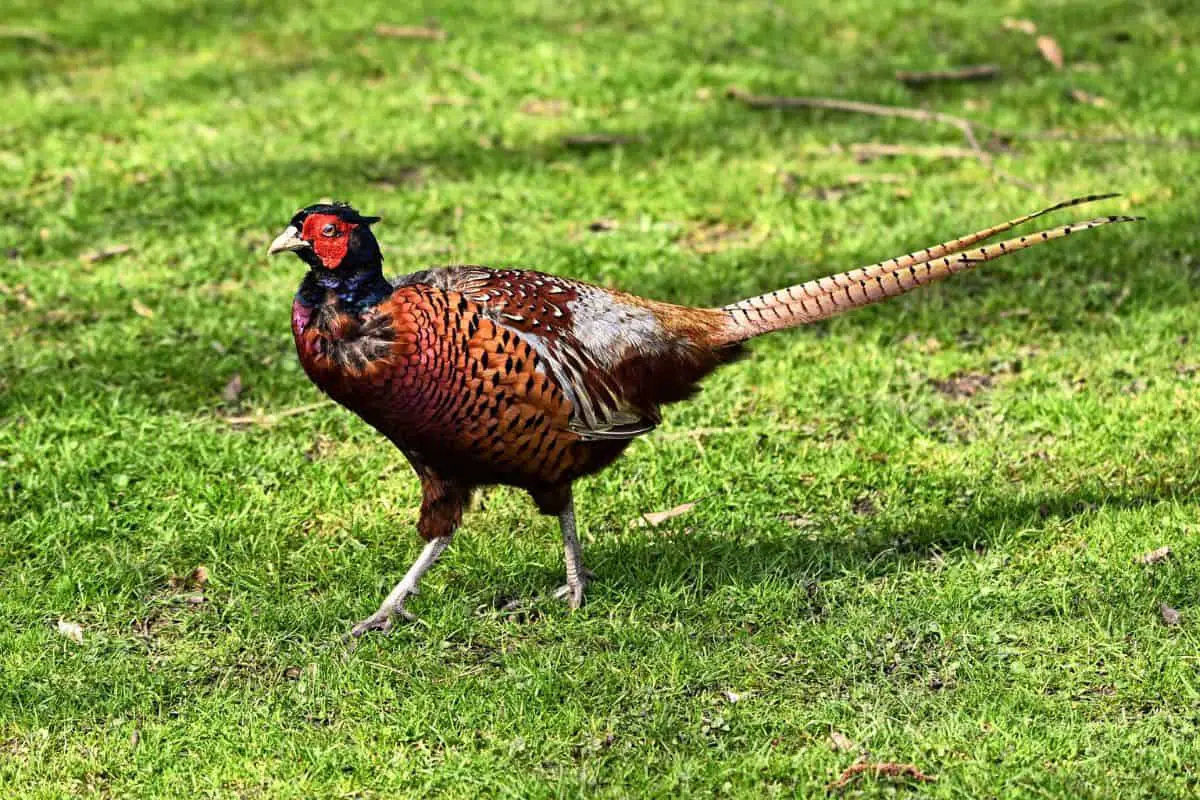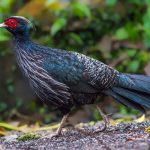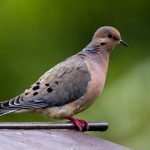Common Name: Ring-necked Pheasant
Scientific Name: Phasianus colchicus| Size | Diet | Range in Hawaii | Status in Hawaii |
|---|---|---|---|
| 24 in. - 36 in. | mix of vegetation, insects, and small animals | Common on all islands | Least Concern |
Ring-necked Pheasants are a strikingly beautiful bird species that have been introduced to various parts of the world, including North America and Hawaii. With iridescent copper-and-gold plumage, a red face, and a crisp white collar, males of this species are easily recognizable.
Their rooster-like crowing can be heard from up to a mile away, adding to the charm of this already captivating bird. Native to central and eastern Asia, Ring-necked Pheasants were introduced to North America in the 1880s and quickly became one of the continent’s most popular game birds. In Hawaii, Ring-necked Pheasants were introduced in the 1860s, where they have thrived as a game bird species.
Ring-necked Pheasant
Appearance
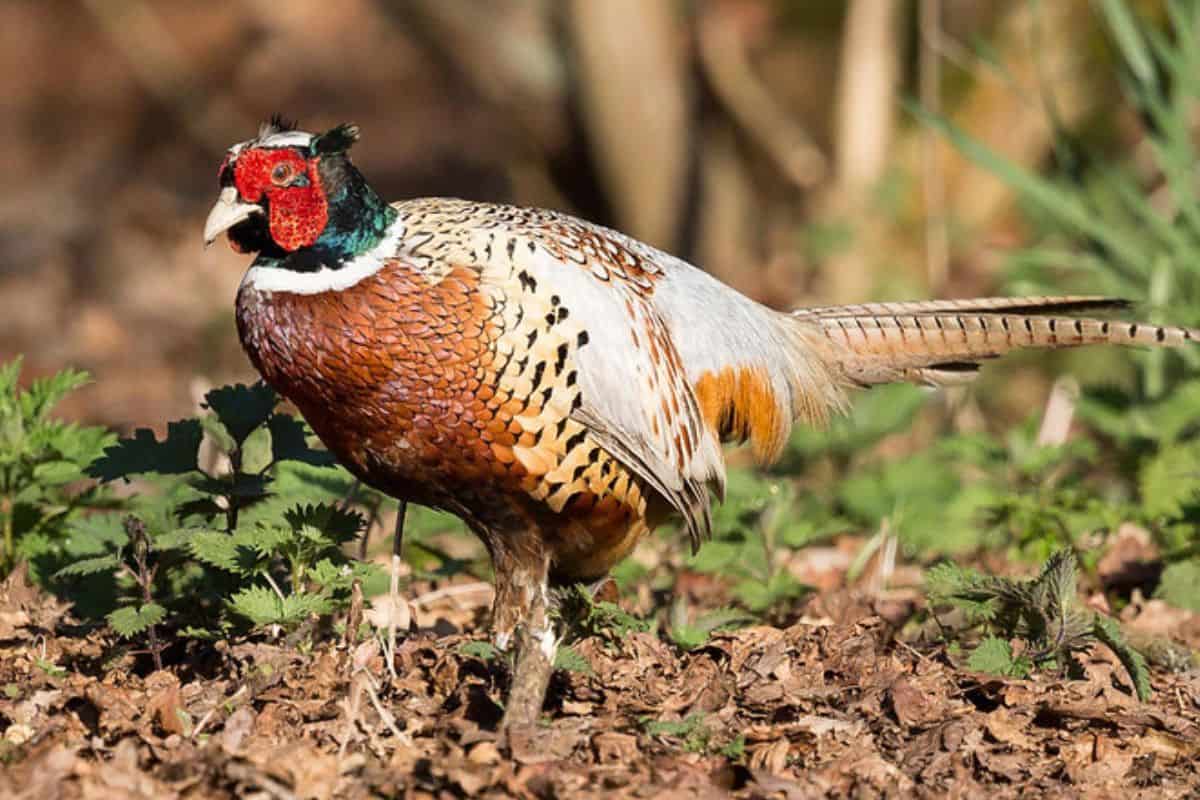
The Ring-necked Pheasant is a stunningly beautiful bird that measures around 24-36 inches in length, including their long, pointed tail. Males are especially striking, with their iridescent copper-and-gold plumage, bright red face, and crisp white collar.
They have a long, pointed tails and a distinctive ring of white feathers around their necks, which gives them their name. Females are more subdued in color, with mottled brown and black feathers that help them blend into their surroundings. Both males and females have a small crest of feathers on their heads, which they can raise or lower depending on their mood.
Diet
Ring-necked Pheasants have a varied diet that includes both plant and animal matter. They are omnivores, which means they eat a mix of vegetation, insects, and small animals.
In the wild, they feed on seeds, berries, and other fruits, as well as insects like grasshoppers and beetles. They will also eat small mammals like mice and voles if they can catch them. When raised in captivity, Ring-necked Pheasants are often fed a diet of grains and seeds, which helps them grow and develop properly.
Nesting
Ring-necked Pheasants are ground-nesting birds, which means they build their nests on the ground rather than in trees or other elevated locations. Females will typically build their nests in tall grass or other vegetation, using materials like twigs, leaves, and grass to create a shallow depression in the ground.
They will lay a clutch of 8-15 eggs, which they will incubate for around 22-25 days. During this time, the female will stay close to the nest to protect the eggs from predators. Once the chicks hatch, they are able to leave the nest within a few hours and will follow the female as she leads them to food and shelter.
Behavior

Ring-necked Pheasants are known for their interesting and sometimes quirky behaviors. During breeding season, males will often engage in elaborate courtship displays, including strutting, puffing up their feathers, and making a series of calls and crows.
They are also territorial birds, and will defend their chosen area from other males. Females are more solitary, and will often hide their nests in tall grass or other vegetation to protect their eggs from predators.
Ring-necked Pheasants are ground-dwelling birds, and will often take cover in tall grass or brush to avoid detection. When startled, they will burst into flight, making a distinctive whirring sound with their wings.
Habitat
Ring-necked Pheasants are a highly adaptable species that can thrive in a variety of habitats. They are native to central and eastern Asia, but have been introduced to other parts of the world, including North America and Hawaii.
In the wild, they are found in grasslands, fields, and other open areas with plenty of vegetation for cover and food. They are also commonly found near water sources like streams and ponds. When raised in captivity, Ring-necked Pheasants can adapt to a variety of environments, including farms, game preserves, and urban areas.
Range
Ring-necked Pheasants were introduced to Hawaii in the 1860s and have since become established as a game bird species. They are found on all the main islands of Hawaii, including Maui, Kauai, Oahu, and the Big Island.
In Hawaii, Ring-necked Pheasants are typically found in grasslands, agricultural fields, and other open areas with plenty of cover and food. They are a popular game bird species in Hawaii and are often hunted by both locals and tourists.
Conservation Status
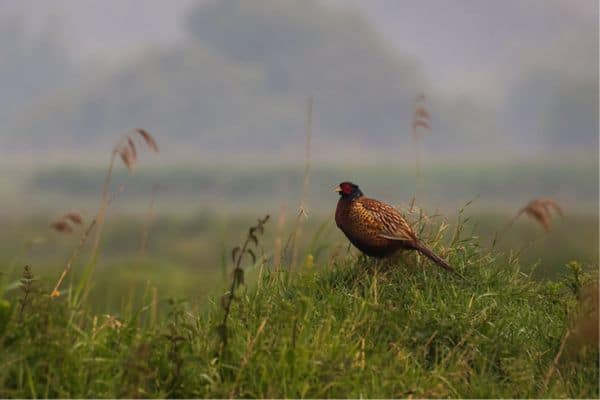
Ring-necked Pheasants are currently classified as a species of least concern by the International Union for Conservation of Nature (IUCN). This means that their populations are stable and not currently at risk of extinction. However, their conservation status can vary depending on the region and habitat, and there are some areas where populations have declined due to habitat loss, hunting, and predation by other animals.
Interesting Facts
1. They fly short distances
They are able to fly short distances, but prefer to run and hide in tall grass or brush to avoid detection.
2. Highly adaptable
Ring-necked Pheasants are highly adaptable and can thrive in a variety of habitats, including grasslands, fields, and other open areas with plenty of vegetation for cover and food.
3. Distinctive crowing call
They have a distinctive crowing call that can be heard from up to a mile away, and is often associated with the sounds of rural areas.
4. Variety of interesting behaviors
Ring-necked Pheasants have been known to display a variety of interesting behaviors, including dust-bathing, sunning, and preening.
Frequently Asked Questions
1. What is the lifespan of a Ring-necked Pheasant?
The lifespan of Ring-necked Pheasants in the wild is typically around 2-3 years, although they can live up to 5 years in captivity.
2. What do female Ring-necked Pheasants look like?
Female Ring-necked Pheasants are more subdued in color, with mottled brown and black feathers that help them blend into their surroundings.
3. How do Ring-necked Pheasants communicate?
Ring-necked Pheasants communicate through a variety of vocalizations, including crows, calls, and alarm sounds.
4. Are Ring-necked Pheasants social animals?
Ring-necked Pheasants are generally solitary animals, although they may form small groups during the winter months.
5. How fast can Ring-necked Pheasants run?
They are able to run at speeds of up to 8-10 miles per hour.
